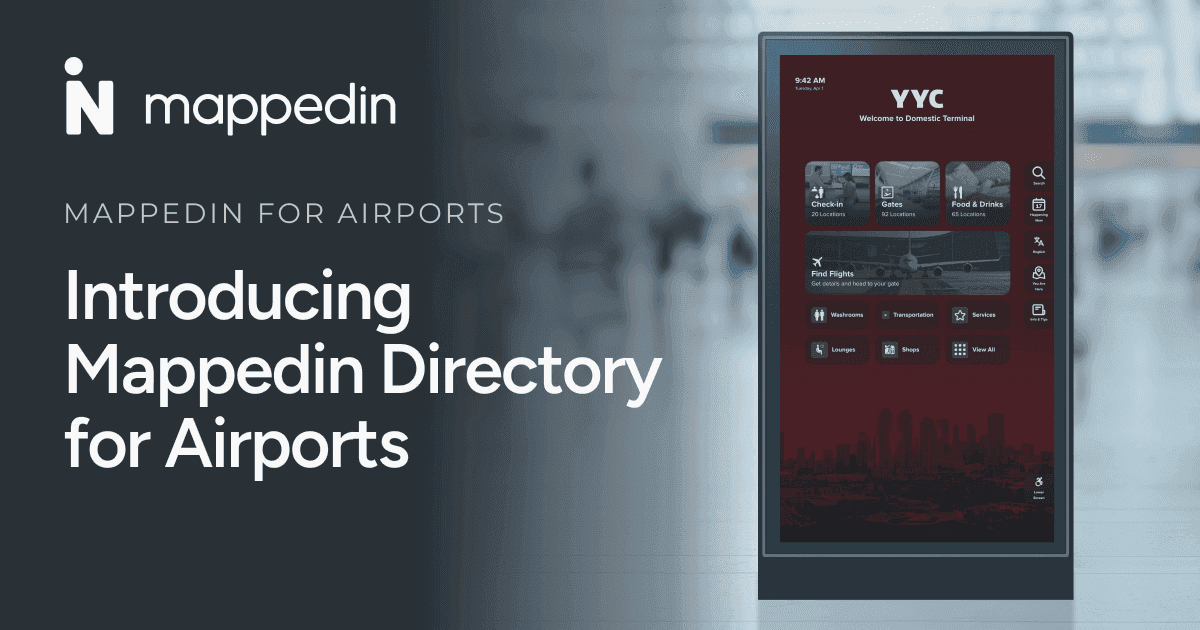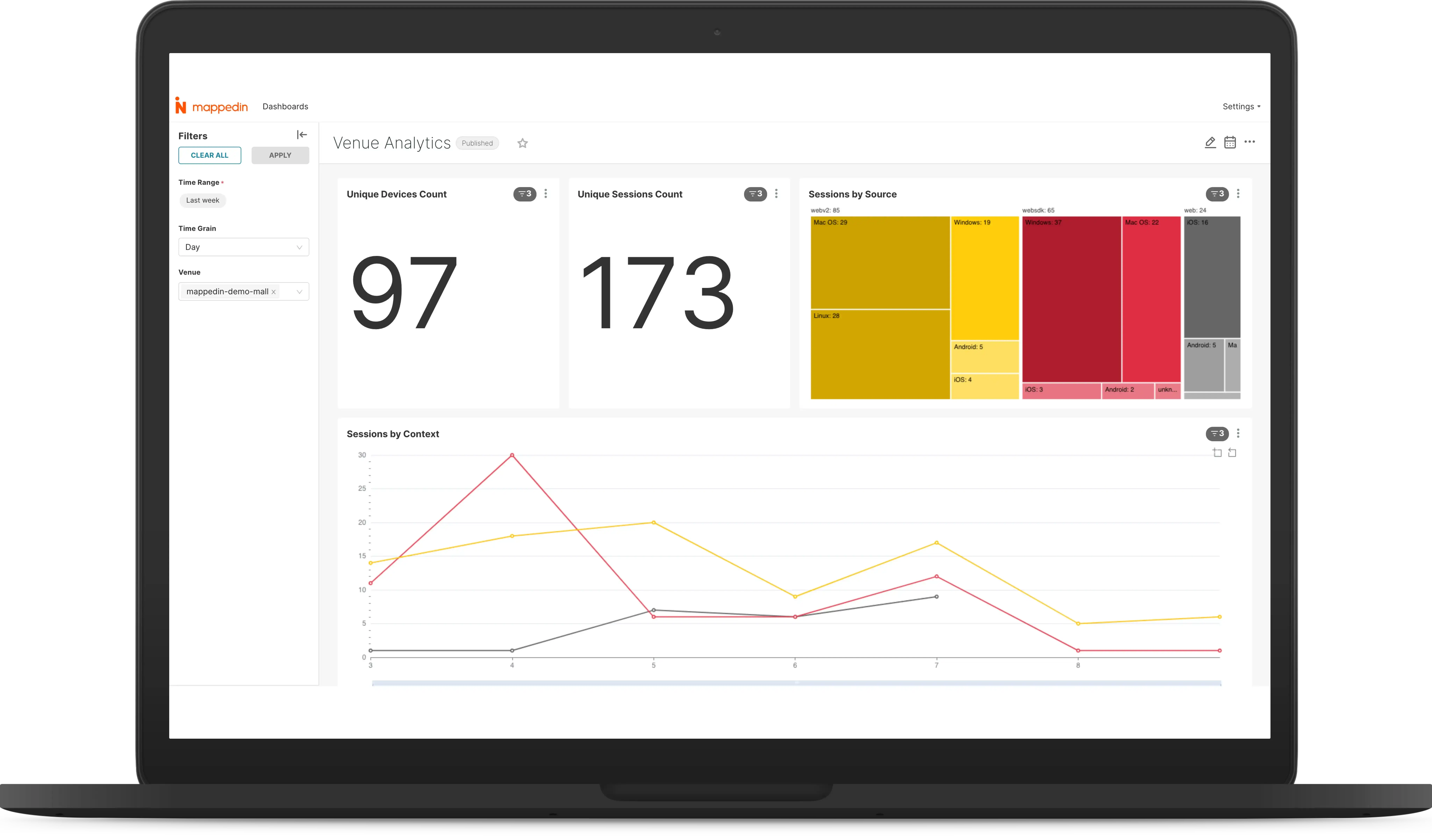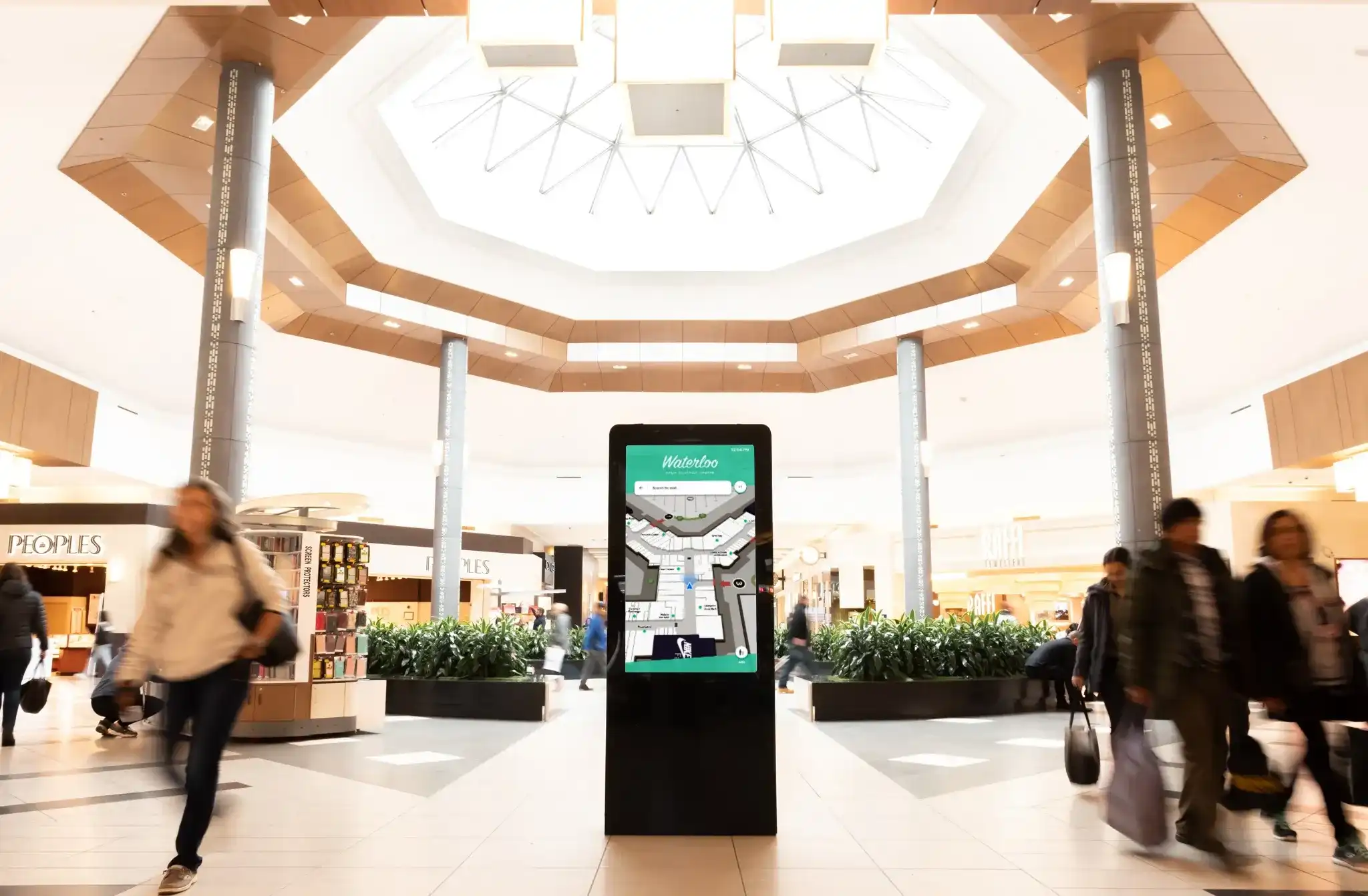Indoor positioning software elevates indoor mapping experiences by enabling users to accurately visualize their real-time position within a venue. While this technology helps customers navigate indoor spaces, it also proves valuable for businesses in another way: by equipping them with valuable insights and analytics.
Keep reading to find out how you can leverage location data to make smarter, more informed decisions for your business, and ultimately drive increased foot traffic and revenue at your property.
Indoor positioning systems
An indoor positioning system (IPS) can be thought of as GPS for indoor venues. Using a variety of methods, these systems can detect real-time locations to determine the coordinates of people or assets inside a building. Often, these coordinates are represented visually by a blue dot on a digital indoor map to provide additional context to users. Similar to outdoor GPS, users are not required to enter a “Start” destination and as they begin to follow along a route, the blue dot moves with them, providing seamless wayfinding and step-by-step navigation.
Indoor positioning analytics
With indoor positioning technology and an indoor mapping platform, property managers are able to access analytical data on how their map is used by customers. This includes detailed reports on visitors, how they interact with your space, and their intent while visiting your property. You’re able to gain a better understanding of what your customers are looking for and leverage this information to your advantage.

Mappedin’s Analytics Dashboard is a comprehensive tool that showcases location-based details of visits, such as user behaviour, most popular location searches, missed searches, language selections, device use, and more. Some trends and insights include:
- Number of Sessions
- Length of Sessions
- Device Used
- Event Selections
- Quick Link Selections
- Category Selections
- Locations Selected from Search
- Characters Typed During Search
- ...and more
Leveraging indoor positioning trends and insights
Once your business is equipped with a powerful indoor mapping platform, you can easily gather insights and visualize trends that will help you make critical business decisions. In addition, there are indoor mapping platforms such as Mappedin that enable you to export visual reports and raw data. This allows you to pull the data into any system with ease, making it simple to explore your venue metrics and track trends over time from any given program.
These insights help you understand your customers better, which in turn helps with customer acquisition and retention. By leveraging indoor positioning data, you can identify potential areas for investment, create targeted content, promotions, and events that drive increased foot traffic, and optimize your venue layout to boost sales.
Identify potential areas for investment
Meet Customer needs
Facility managers can generate spatial analytics with maps and better understand user intent through search data, providing a broader picture of what customers are looking for. For instance, missed searches allow you to see what locations, categories, or brands your visitors are looking for that currently don’t exist at your venue. This report can help identify potential areas for investment that would increase sales at your property. If you notice that a large majority of your visitors are searching for a specific store at your mall, vendor at your stadium, or other location that doesn’t currently exist at your venue, you may consider adding it.
Wayfinding applications
You can also break down analytics and look at the different usage across various wayfinding applications within the same venue, or you could go one step further and look at for example, the difference in usage across digital directories at your property. This can give you valuable information such as the word “coffee” is being searched 20x more at one directory location over another. As such, you may consider adding a coffee shop near that directory to garner more sales and cater to your customers. Moreover, with a web application, leveraging analytics such as the device used can help guide other decisions. For example, you might have a venue application built purely for iOS devices, but a large amount of your visitors use Android devices. Then you may consider creating an app for Android devices to reach these customers.
Integrated technologies
Indoor positioning analytics can highlight real-time events within a space for a variety of purposes, and can be leveraged across different industries for business improvements. For example, tracking important assets such as documents, building material, equipment, employees, etc. can be used to increase efficiencies. Location analytics can also be pulled from other integrations with your indoor mapping software, such as an integrated workplace management system. Along with asset tracking and accessing various workplace services, maps allow employees to raise issues when a vending machine breaks, or a fax machine malfunctions, or any other issue occurs, and these insights can be used to make decisions about your property. If you notice that an ATM machine or printer is being reported as broken several times a month, it may be worth investing in a new one in order to increase workplace efficiency and employee productivity.
Targeted content, promotions and events
By discovering what your visitors are looking for, you can improve marketing strategies and serve up highly relevant content, promotions, and events that drive increased foot traffic and revenue at your property. For instance, if you notice that visitors are constantly searching for food and drinks at your venue, you could send push notifications of nearby vendors to draw their attention. Indoor positioning enables you to send personalized offers when guests are passing by locations, such as stores or concession stands, to prompt them into making a purchase. If someone is walking by a restaurant at your venue, you could send a “15% off coupon code” to grasp their attention. Alternatively, you can use proximity marketing to notify customers of ongoing sales and promotions happening within your venue.
Indoor positioning analytics help you understand visitors’ routines, and helps you better target them both inside and outside of your venue. With a mobile app, you can target app users and motivate them to visit your property by sending personalized reminders of events, or ongoing deals or services that will capture their interest. With digital directories implemented across your venue, you can also drive attention to events and services by promoting them directly on the screen. Using the indoor positioning analytics, you can explore the results of different tactics and see what campaigns and strategies are working in real-time. This provides you with key information on how you’re attracting customers that you can leverage to your advantage.
Optimize your venue layout
Indoor positioning analytics highlight how people move around your venue and can expose ways that your business can optimize its space. If a business can see exactly where customers are at any given time, data can be gathered on what areas of the venue are seeing the most traffic, which areas are being ignored, what paths customers are taking when they walk into your venue, how long they stay for, and whether they wandered aimlessly or went straight to a specific area. These insights can then be leveraged to make informed business decisions that enable space optimization and improve the spatial layout of services to maximize sales.
If visitors are gathering in certain areas of your venue, you can monetize these spaces by adding paid services, vendors, and amenities in this area. For instance, if passengers gather around a specific area in your airport, you can drive business by adding more retailers. Similarly, in a stadium or arena, you can add concession stands in areas where people are travelling through and occupying the most. No matter the venue, you can monetize popular areas to boost sales for your business. You can also relocate and move around items to make sure they are in the most optimal location to gain attention. For instance, retailers can use real-time analytics to monitor the success of their product placement and displays, and move them away from areas that are ignored. Overall, understanding which areas of your venue garner the most foot traffic helps you optimize your venue layout.
No matter the venue or industry, indoor positioning software can provide you with valuable insights and analytics. To learn more about this technology, and how you can leverage indoor positioning data to benefit your business, contact us today.
Tagged In
Share


